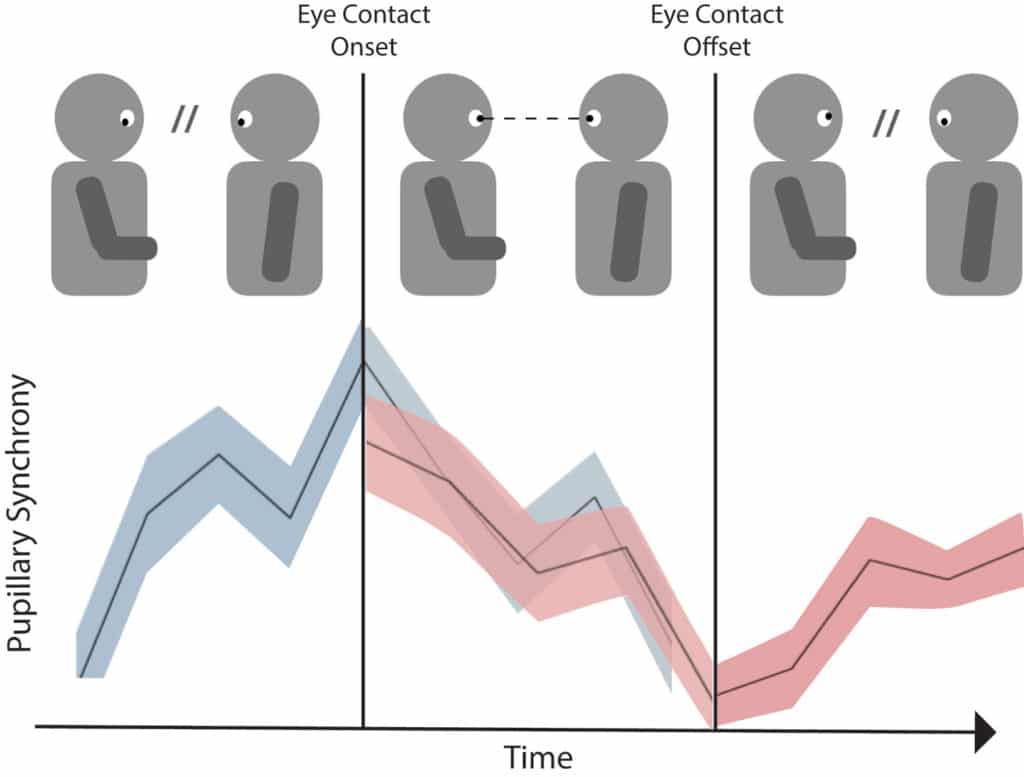Making (and breaking) eye contact makes the conversation more engaging.
BY PRANJAL MEHAR
SEPTEMBER 12, 2021

Image: Pixabay
What makes a good conversation? A new study suggests an answer: making and breaking conversation.
The study by Dartmouth College reports that while making conversation, eye contact occurs during moments of ‘shared attention’ with their pupils dilating in synchrony as a result.
Previously, it was believed that eye contact creates synchrony, but this new study suggests it’s not that simple. Eye contact occurs when we are already in sync, and if anything, eye contact seems to help break that synchrony.
Eye contact may usefully disrupt synchrony momentarily to allow for a new thought or idea.
Scientists brought pairs of students in the lab to study the relationship between eye contact and pupillary synchrony in a meaningful conversation.

Journal Reference:
Sophie Wohltjen et al., Eye contact marks the rise and fall of shared attention in conversation, PNAS (2021). DOI: 10.1073/pnas.2106645118
What makes a good conversation? A new study suggests an answer: making and breaking conversation.
The study by Dartmouth College reports that while making conversation, eye contact occurs during moments of ‘shared attention’ with their pupils dilating in synchrony as a result.
Previously, it was believed that eye contact creates synchrony, but this new study suggests it’s not that simple. Eye contact occurs when we are already in sync, and if anything, eye contact seems to help break that synchrony.
Eye contact may usefully disrupt synchrony momentarily to allow for a new thought or idea.
Scientists brought pairs of students in the lab to study the relationship between eye contact and pupillary synchrony in a meaningful conversation.

Cartoon of how a single instance of eye contact coincides with pupillary synchrony. Prior to eye contact, pupillary synchrony increases until it peaks at eye contact onset. As eye contact is maintained, synchrony declines until its trough when eye contact is broken. Credit: Sophie Wohltjen.
The students were asked to wear eye-tracking glasses and sitting across from each other. Each pair were asked to have a conversation for 10 minutes, which was audio and video recorded.
After the conversation was over, the two participants were separated into different rooms. They were asked to watch the conversation they just had and continuously rate how engaged they were.
Scientists showed how pupillary synchrony increases and decreases around instances of eye contact. They found that people make eye contact as pupillary synchrony is at its peak. Pupillary synchrony then immediately decreases, only recovering again once eye contact is broken. The data also demonstrated a correlation between instances of eye contact and higher levels of engagement during the conversation.
Lead author Sophie Wohltjen, a graduate student in psychological and brain sciences at Dartmouth, said, “Eye contact is immersive and powerful. When two people are having a conversation, eye contact signals that shared attention is high—that they are in peak synchrony with one another. As eye contact persists, that synchrony then decreases. We think this is also good because too much synchrony can make a conversation stale. An engaging conversation requires, at times, being on the same page and, at times, saying something new. Eye contact seems to be one way we create a shared space while also allowing space for new ideas.”
“Conversation is a creative act in which people build a shared story from independent voices. Moments of eye contact seem to signal when we have achieved shared understanding and need to contribute our independent voice.”
The students were asked to wear eye-tracking glasses and sitting across from each other. Each pair were asked to have a conversation for 10 minutes, which was audio and video recorded.
After the conversation was over, the two participants were separated into different rooms. They were asked to watch the conversation they just had and continuously rate how engaged they were.
Scientists showed how pupillary synchrony increases and decreases around instances of eye contact. They found that people make eye contact as pupillary synchrony is at its peak. Pupillary synchrony then immediately decreases, only recovering again once eye contact is broken. The data also demonstrated a correlation between instances of eye contact and higher levels of engagement during the conversation.
Lead author Sophie Wohltjen, a graduate student in psychological and brain sciences at Dartmouth, said, “Eye contact is immersive and powerful. When two people are having a conversation, eye contact signals that shared attention is high—that they are in peak synchrony with one another. As eye contact persists, that synchrony then decreases. We think this is also good because too much synchrony can make a conversation stale. An engaging conversation requires, at times, being on the same page and, at times, saying something new. Eye contact seems to be one way we create a shared space while also allowing space for new ideas.”
“Conversation is a creative act in which people build a shared story from independent voices. Moments of eye contact seem to signal when we have achieved shared understanding and need to contribute our independent voice.”
Journal Reference:
Sophie Wohltjen et al., Eye contact marks the rise and fall of shared attention in conversation, PNAS (2021). DOI: 10.1073/pnas.2106645118
No comments:
Post a Comment